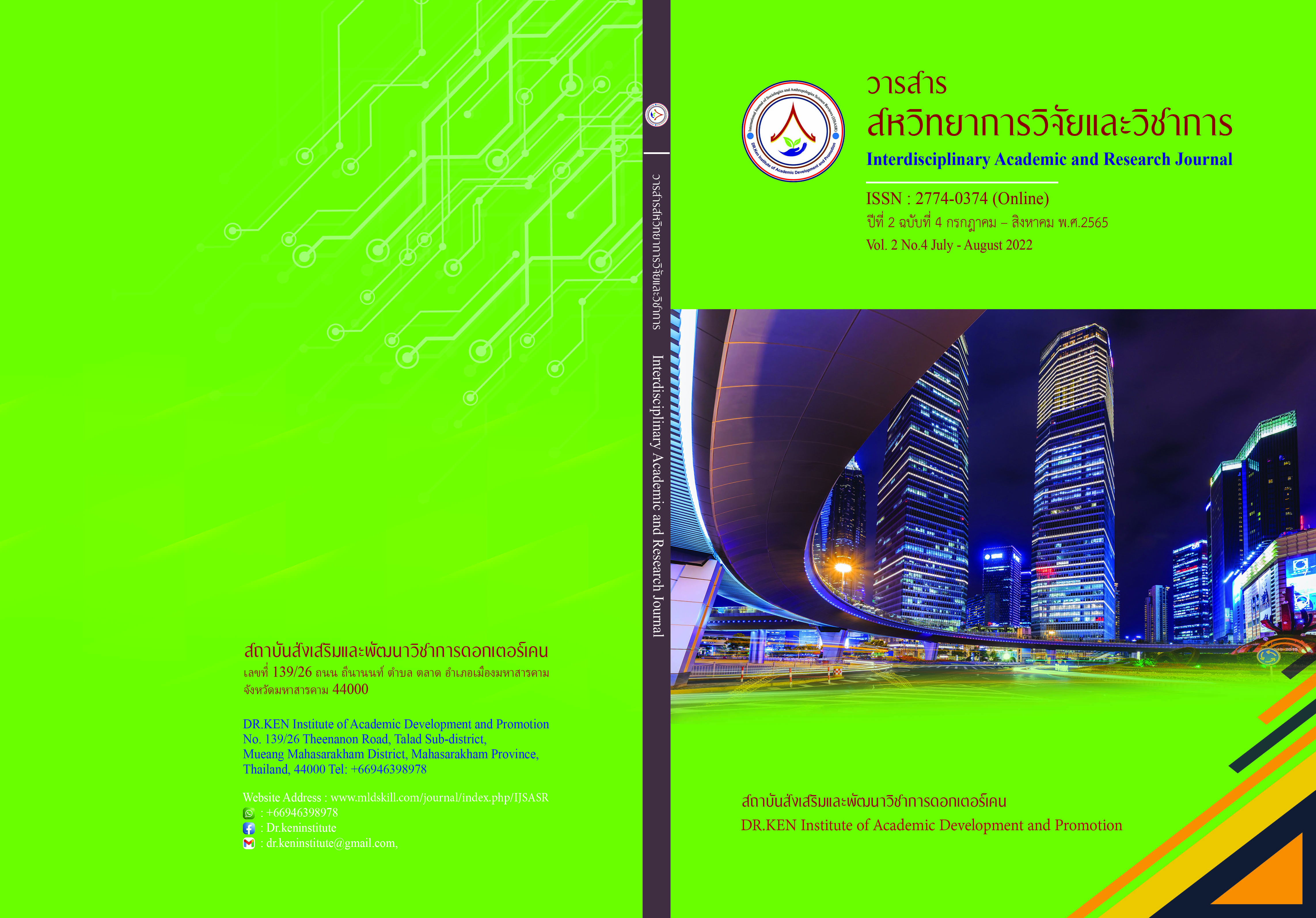Valuable Living and Quality of Life for the Elderly in the 21st Century
DOI:
https://doi.org/10.14456/iarj.2022.75Keywords:
Valuable living; , Quality of life; , ElderlyAbstract
From the situation that Thai society is currently facing, whether the working age has to take care of the elderly, the elderly are more alone, the elderly depend on their children's income decreasing, There is a tendency for a shortage of formal labor, the state has increased expenditure on health and pension for the elderly. Therefore, the purposes of this research were: 1) to study the valuable living of the elderly in the 21st century. 2) to study the quality of life of the elderly in the 21st century, and 3) to test valuable living on the quality of life of the elderly in the 21st century. Collecting data from 400 elderly in the Northeast and a set of questionnaires were the research tool. Statistics used for data analysis were mean, standard deviation, multiple correlation analysis, and stepwise multiple regression analysis. The results revealed the following findings; 1) elderly had opinions about valuable living in general aspect at a high level and had an average of 3.97, the averages are arranged in descending order as follows: knowledge building and good attitude aspect had an average of 3.99, the aspect of promoting a feeling of satisfaction aspect had an average of 3.98, behavioral aspects that support longevity aspect had an average of 3.94., 2) elderly had opinions about quality of life in general aspect at a high level and had an average of 3.98, the averages are arranged in descending order as follows: mental aspect had an average of 4.07, social integration aspect had an average of 4.05, rights and liberties aspect had an average of 3.95, self development aspect had an average of 3.89, and physical aspect had an average of 3.87, and 3) valuable living had positive relationship and impact on quality of life of the elderly in the 21st century and the forecast in standard score (b) form of 0.558, 0.239, and 0.164, and has a multiple correlation coefficient (R) of 0.792, a forecasting power (R2) of 0.627, and a forecasting power of 62.70%.
References
กรมกิจการผู้สูงอายุ. (2561). ยุทธศาสตร์กรมกิจการผู้สูงอายุ 20 ปี ประจำปี พ.ศ. 2561 – 2580. กรุงเทพฯ : สามลดา.
กรมกิจการผู้สูงอายุ. (2563). สถิติผู้สูงอายุของประเทศไทย 77. [ออนไลน์]. https://www.dop.go.th/th/know/side/1/1/335. [15 May 2021]
นัสมล บุตรวิเศษ และอุปริฏฐา อินทรสาด. (2564). ปัจจัยที่ส่งผลต่อคุณภาพชีวิตของผู้สูงอายุ: กรณีศึกษาอำเภอพระนครศรีอยุธยา จังหวัดพระนครศรีอยุธยา. มหาวิทยาลัยเทคโนโลยีราชมงคลสุวรรณภูมิ ศูนย์พระนครศรีอยุธยา.
พรสรรค์ ปิยนันทิศักดิ์. (2563). รูปแบบการส่งเสริมคุณภาพชีวิตของผู้สูงอายุโดยชุมชนในจังหวัดขอนแก่น. วารสารสถาบันวิจัยและพัฒนา มหาวิทยาลัยราชภัฏมหาสารคาม, 7(2) : 209-226.
มูลนิธิสถาบันวิจัยและพัฒนาผู้สูงอายุไทย (มส.ผส.). (2564). สถานการณ์ผู้สูงอายุไทย พ.ศ. 2563. นครปฐม: สถาบันวิจัยประชากรและสังคม มหาวิทยาลัยมหิดล.
ศรันยา สถิต. (2559). ปัจจัยที่มีความสัมพันธ์กับคุณภาพชีวิตของผู้สูงอายุในตำบลเกาะขนุนอำเภอพนมสารคาม จังหวัดฉะเชิงเทรา. วารสารราชนครินทร์. 13(30), 133-141.
อนุชา ม่วงใหญ่. (2561). แนวคิด และวิธีการ เพื่อการดำรงชีวิตอย่างมีคุณค่าของผู้สูงอายุ. การประชุมวิชาการระดับชาติพะเยาวิจัย ครั้งที่ 7 มหาวิทยาลัยพะเยา, 2510-2518.
เอกพันธ์ คำภีระ อัมพร ยานะ และ อรัญญา นามวงศ์. (2563). ปัจจัยที่สัมพันธ์กับระดับคุณภาพชีวิตของผู้สูงอายุในเขตอำเภอเมือง จังหวัดพะเยา. วารสารวิชาการสุขภาพภาคเหนือ. 7(2), 44-57.
Black, K. (2006). Business statistics for contemporary decision making. 4thed. New York: John Wiley and Sons.
Krejcie, R. V., and Morgan, D. W. (1970). Determining Sample Size for Research Activities. Educational and Psychological Measurement. 30, 607-610.
Downloads
Published
How to Cite
Issue
Section
License
Copyright (c) 2022 Auscharaporn Chalermchit, Pornwadee Ruksasri, Kotchanipa Wanichkittikul, Nava Masaunjik, Piyawan Yangkham

This work is licensed under a Creative Commons Attribution-NonCommercial-NoDerivatives 4.0 International License.
Copyright on any article in the Interdisciplinary Academic and Research Journal is retained by the author(s) under the under the Creative Commons Attribution-NonCommercial-NoDerivatives 4.0 International License. Permission to use text, content, images, etc. of publication. Any user to read, download, copy, distribute, print, search, or link to the full texts of articles, crawl them for indexing, pass them as data to software, or use them for any other lawful purpose. But do not use it for commercial use or with the intent to benefit any business.
















.png)


